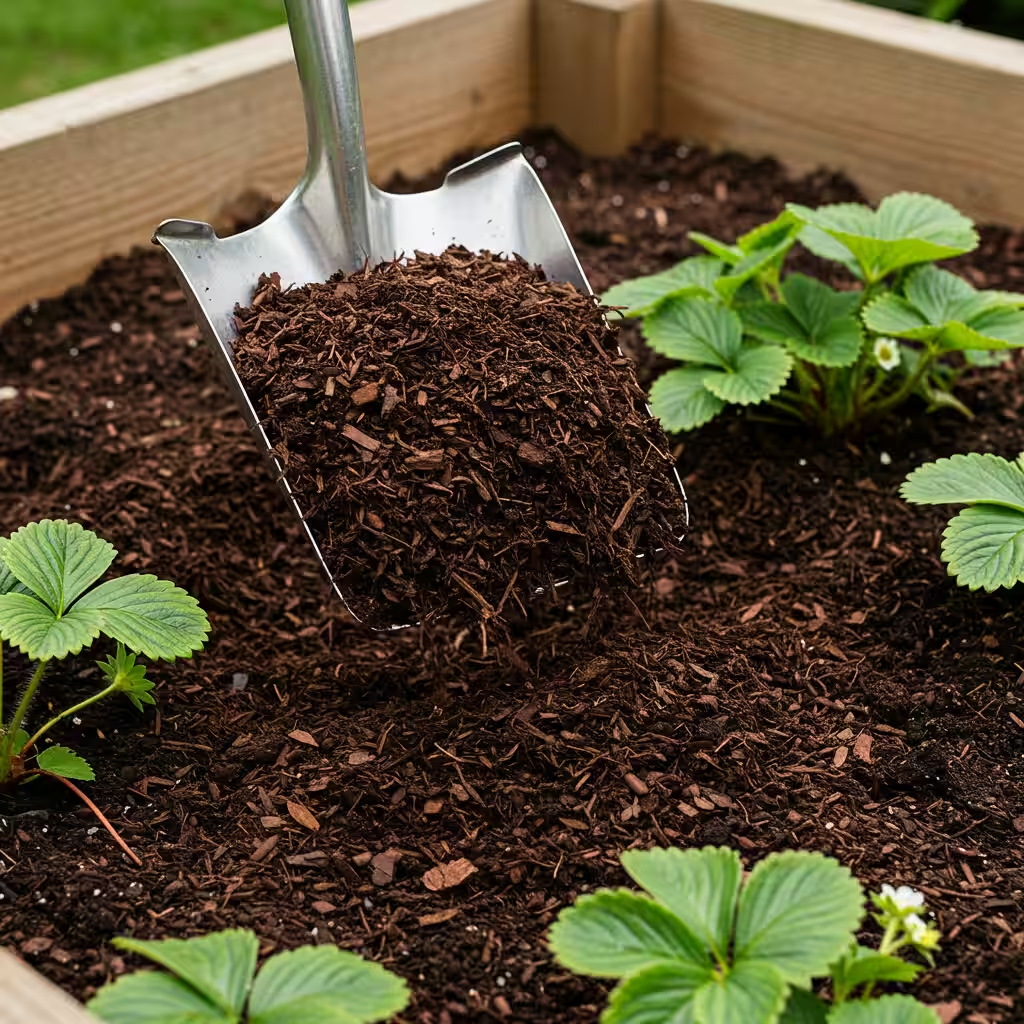If you’ve been looking for a game-changer in your garden that can reduce your workload while boosting plant health, wood chip mulch might be your new best friend. I’ve been using wood chips in my garden for years, and the transformation has been nothing short of remarkable.
For many of us gardeners, spreading organic mulch becomes an essential ritual—both when creating new beds and rejuvenating established ones. The moisture retention and weed suppression alone make it worth your time and effort.
Let me be straight with you: if maintaining a low-maintenance garden is your goal, mulching isn’t optional—it’s necessary.
Why Wood Chips Outshine Other Mulches
Organic mulches mimic nature’s own process of continually dropping sticks, branches, bark, and leaves in forest ecosystems. Our garden plants evolved surrounded by these layers of plant debris and have adapted to thrive with all the benefits this natural blanket provides.
Arborist wood chips are the closest match to this natural forest mulching. Created from freshly chipped tree branches and brush, these chunky pieces (typically 2-4 inches long and 1-2 inches wide) create the perfect protective layer for your garden.
7 Powerful Reasons to Use Wood Chip Mulch
1. Stops Weeds in Their Tracks
I can’t tell you how many hours I’ve saved on weeding since switching to wood chips. When spread at least 4 inches deep, wood chip mulch smothers most annual weeds before they have a chance to emerge. The thick layer prevents seeds from germinating and blocks sunlight from reaching persistent perennial weeds.
Your plants will thank you too—without competition from weeds, they’ll have exclusive access to nutrients, water, and space. The difference in plant growth is often dramatic!
2. Keeps Moisture Where You Need It
During hot summer days, uncovered soil loses water quickly through evaporation. A good layer of wood chips acts like a protective shield, keeping that precious moisture in the ground where your plants can use it.
Here’s a pro tip I’ve learned: coarser mulches with larger particles (like wood chips) work better for moisture retention than fine mulches like compost or sawdust. Those finer materials can actually wick moisture up and away from the soil. Using chunkier wood chips with particles at least 1 inch in size means fewer trips with the watering can!
3. Builds Richer Soil Naturally
One of my favorite things about wood chip mulch is watching it transform my soil over time. As these organic materials break down over the seasons, they dramatically improve soil health. I’ve noticed my garden beds developing:
- Higher nutrient levels
- Better moisture-holding capacity
- Increased soil porosity
- Improved overall soil structure
The plants respond with stronger, more extensive root systems—it’s like giving them the perfect environment to thrive.
4. Creates a Thriving Underground Ecosystem
Fresh, undecomposed wood chips provide an ideal food source for beneficial soil microbes and fungi—especially those magical mycorrhizal fungi that form partnerships with plant roots. These microscopic helpers break down the wood chips and convert them into nutrients your plants can easily absorb.
This boost in soil microorganism activity creates a healthier growing environment by naturally suppressing root diseases and soil pathogens. You’ll know this process is working when you pull back your mulch and see the soil covered with a fine, webby network of white fungal threads and partially decomposed woody bits.
5. Protects Plants from Temperature Extremes
Just like a good blanket, wood chip mulch insulates your soil, keeping it cooler in summer and warmer in winter. During hot weather, it shades the ground and slows moisture loss, protecting your plants from heat stress and dehydration.
In colder periods, mulch stabilizes soil temperatures, preventing rapid fluctuations between day and night. This natural temperature regulation extends your growing season well into fall and helps plants bounce back quicker in spring.
6. Prevents Soil Erosion
I learned this benefit the hard way after a season of heavy rains washed away much of my unprotected topsoil. Bare soil is particularly vulnerable to erosion from rain, wind, and slopes.
A thick layer of wood chips shields your soil from direct hits by intense rain or hail, keeps it in place when winds kick up, and prevents soil from washing away on sloped terrain. This protection preserves those nutrient-rich upper layers of soil that your plants depend on.
7. Lasts Longer Than Other Mulches
While there are many mulching materials available, wood chips stand out for their longevity. Unlike finely shredded mulch that quickly breaks down and needs yearly replacement, arborist wood chips decompose much more slowly due to their larger size.
The general rule I follow is that 1 inch of wood chips will last approximately one year. Apply 4 inches or more, and you might not need to mulch again for 4+ years! This makes wood chips not only effective but also economical and time-saving.
Addressing Common Concerns About Wood Chip Mulch
You may have heard some negative claims about wood chip mulch floating around the internet. Let me address these concerns based on my experience and research:
“Wood chips steal nitrogen from the soil”
While wood chips do require nitrogen to decompose, there’s no substantial evidence that wood chip mulch causes significant nitrogen deficiencies in established plants. The decomposition primarily affects the very top layer of soil, which is why I avoid mulching directly around delicate seedlings until they’re well-established.
“Wood chip piles can spontaneously combust”
This is simply not a concern for home gardeners. For wood chips to generate enough heat to catch fire, piles would need to be enormous—we’re talking industrial-scale piles over 60 feet tall!
“Wood chips attract termites”
In my experience, termites are just as likely to be found under bare soil or decorative gravel. That said, it’s always wise to keep any type of mulch pulled back about 8-12 inches from your home’s foundation, siding, and windowsills.
“Walnut wood chips will kill my plants”
While black walnut does contain allelopathic compounds that can inhibit plant growth, these chemicals break down rapidly once the wood is chipped and exposed to the environment. I’ve used mixed wood chips containing walnut without any negative effects on my established plants.
“Pine wood chips will make my soil too acidic”
This is a persistent myth that simply isn’t supported by evidence. It would take decades of heavy pine mulching to have any measurable impact on your soil pH. Even if you’re growing acid-loving plants like blueberries or rhododendrons, pine mulch won’t significantly change your soil acidity.
“Wood chips will spread tree diseases”
As long as wood chips remain on the soil surface (rather than being worked into the soil), the risk of disease transmission is minimal. Most pathogens that affect trees won’t survive the chipping process or the competitive environment of the decomposing mulch layer.
4 Ways to Get Wood Chip Mulch for FREE
Now for the really good news—you can often get wood chip mulch completely free if you know where to look! Here’s how I’ve sourced free mulch for my garden:
1. Contact Local Arborists
Certified arborists regularly trim and remove trees, generating tons of wood chips in the process. Rather than paying disposal fees, many are happy to dump these chips at your property.
Try these approaches:
- When having tree work done on your property, ask to keep the chips
- Call local arborists and ask to be put on their list for free wood chip drops
- Look for arborist trucks working in your neighborhood and ask if they have chips to spare
Getting wood chips directly from arborists ensures freshness and lets you know exactly where the material came from—no mystery wood or potential contaminants.
2. Watch for Utility Company Crews
Utility companies regularly trim trees around power lines, especially after storms. These crews typically have a wood chipper and dump truck with them, and most are more than happy to unload their chips on your property instead of paying disposal fees.
If you spot a crew working in your area, simply ask if they’d be willing to drop off their load of wood chips. I’ve had great success with this approach after strong storms have blown through our area.
3. Check Community Programs
Many towns, cities, and landfills run green waste programs where they collect and process yard waste from residents. This material is often chipped and made available to the public for free.
To take advantage:
- Call your local municipal waste department to ask about mulch giveaways
- Bring your own containers, shovels, and transportation
- For small amounts, use heavy-duty bags or plastic totes
- For larger quantities, a pickup truck or trailer works best
4. Sign Up for ChipDrop
ChipDrop is an online service that connects arborists who have wood chips with gardeners who want them. Simply create an account, submit a request, and wait for your free delivery.
A few things to keep in mind with ChipDrop:
- Be prepared to accept a full dump truck load (up to 20 cubic yards)
- Delivery timing is unpredictable—could be same day or several weeks
- You may not be home when chips are delivered, so designate a spot clearly
- Consider uploading a photo of your drop site and marking it with a flag or cone
How to Use a Large Pile of Wood Chips
Don’t be intimidated by a massive pile of wood chips—they’ll disappear faster than you might think! Here’s how I put wood chips to use throughout my garden:
- Create new ornamental beds or refresh existing ones with a 4-inch layer
- Apply around perennials, shrubs, and trees (keeping it 8 inches away from trunks)
- Use in containers, raised beds, and window boxes
- Create attractive, low-maintenance garden paths
- Add to established vegetable gardens (between rows, not directly around young seedlings)
- Use excess chips as the “brown” carbon material in your compost pile
Wood Chip Mulching Tips for Success
To get the most benefit from your wood chip mulch:
- For maximum soil enrichment, use fresh tree trimmings that include both wood and leaves
- For the best weed suppression, apply wood chips 4-12 inches deep
- For longest-lasting mulch, look for chip pieces larger than 1 inch
- Check soil moisture periodically by pulling back the chips and testing with your finger
- When watering, irrigate deeply to ensure moisture penetrates through to the soil
- Keep mulch pulled back from the base of plants to prevent rot issues
- While risks are low, try to get wood chips from reputable sources to avoid introducing problems
I’ve transformed my garden from a weed-filled, water-hungry maintenance nightmare into a thriving, largely self-sustaining ecosystem—and wood chip mulch has been a key part of that journey. Give it a try, and I think you’ll be just as impressed with the results!
Are you ready to give wood chip mulch a try in your garden? Do you have any questions about using it effectively? Let me know in the comments below!

